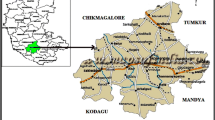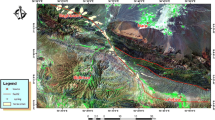Abstract
This study evaluates the quality of drinking water samples (sample size = 52) taken from various locations of Pithoragarh district, Uttarakhand. The parameters include physiochemical properties viz. total dissolved solids (TDS in mg/L), electrical conductivity/salinity (µS/cm), pH and radiological dose attributable to radon in water (µSv/y). TDS values for the tested samples varied within the range of 18–434 mg/L with average value of 148 mg/L. Electrical conductivity and pH for these samples was measured as 36–868 µS/cm (average: 296 µS/cm) and 6.8–8.2 (average: 7.2), respectively. Radon activity concentration for these water samples was measured using scintillation-based radon monitor, immediately after sampling at the location site. Radon activity concentration was measured as 0.6–81.9 Bq/L with an average value of 17.8 Bq/L. The paper also estimates the annual effective ingestion dose (µSv/y), annual effective inhalation dose (µSv/y) and total effective dose (µSv/y) attributable to radon in drinking water samples.







Similar content being viewed by others
References
Cosma C, Moldovan M, Dicu T, Kovacs T (2008) Radon in water from Transylvania (Romania). Radiat Meas 43:1423–1428. https://doi.org/10.1016/J.RADMEAS.2008.05.001
Bajwa BS, Kumar S, Singh S et al (2017) Uranium and other heavy toxic elements distribution in the drinking water samples of SW-Punjab, India. J Radiat Res Appl Sci 10:13–19. https://doi.org/10.1016/j.jrras.2015.01.002
Kumar A, Singh P, Agarwal T et al (2020) Statistical inferences from measured data on concentrations of naturally occurring radon, thoron, and decay products in Kumaun Himalayan belt. Environ Sci Pollut Res 27:40229–40243. https://doi.org/10.1007/s11356-020-09920-9
Semwal P, Agarwal TK, Singh K et al (2019) Indoor inhalation dose assessment for thoron-rich regions of Indian Himalayan belt. Environ Sci Pollut Res 26:4855–4866. https://doi.org/10.1007/s11356-018-3891-0
Ramola RC, Prasad M, Kandari T et al (2016) Dose estimation derived from the exposure to radon, thoron and their progeny in the indoor environment. Sci Rep 6:31061. https://doi.org/10.1038/srep31061
Semwal P, Singh K, Agarwal TK et al (2018) Measurement of 222Rn and 220Rn exhalation rate from soil samples of Kumaun Hills, India. Acta Geophys 66:1203–1211. https://doi.org/10.1007/s11600-018-0124-3
Ramola RC, Choubey VM, Negi MS et al (2008) Radon occurrence in soil–gas and groundwater around an active landslide. Radiat Meas 43:98–101. https://doi.org/10.1016/J.RADMEAS.2007.05.054
Choubey VM, Bartarya SK, Ramola RC (2000) Radon in Himalayan springs: a geohydrological control. Environ Geol 39:523–530
Ramola RC, Rawat RBS, Kandri MS, Choubey VM (1997) Measurement of radon in drinking water and indoor air. Radiat Prot Dosimetry 74:103–106
Choubey VM, Bartarya SK, Ramola RC (2006) Geological controls on radon in Soil and water of Pithoragarh region, Kumaun Himalaya, India. In: Radon investigations in the Czech Republic XI and the 8th international workshop on the Geological Aspects of Radon Risk Mapping.–72–78, Czech Geol. Surv. Prague
Jobbágy V, Kávási N, Somlai J et al (2010) Radioanalytical investigations of uranium concentrations in natural spring, mineral, spa and drinking waters in Hungary. J Radioanal Nucl Chem 286:417–422
Ramola RC, Choubey VM, Prasad Y et al (2006) Variation in radon concentration and terrestrial gamma radiation dose rates in relation to the lithology in southern part of Kumaon Himalaya, India. Radiat Meas 41:714–720
Ramola RC, Choubey VM, Prasad G et al (2011) Radionuclide analysis in the soil of Kumaun Himalaya, India, using gamma ray spectrometry. Curr Sci 1(1):906–914
Bourai AA, Gusain GS, Rautela BS et al (2012) Variations in radon concentration in groundwater of Kumaon Himalaya, India. Radiat Prot Dosimetry 152:55–57
Kumar A, Singh P, Semwal P et al (2021) Study of primordial radionuclides and radon/thoron exhalation rates in Bageshwar region of Kumaun Himalaya, India. J Radioanal Nucl Chem 1:1–7
Sayato Y (1989) WHO guidelines for drinking-water quality. Eisei kagaku 35:307–312. https://doi.org/10.1248/jhs1956.35.307
Radiation) U (United NSC on the E of A (2000) Sources and effects of ionizing radiation. Sources 1
Ajay K, Manpreet K, Rohit M et al (2016) Quantification and assessment of health risk due to ingestion of uranium in groundwater of Jammu district, Jammu & Kashmir, India. J Radioanal Nucl Chem 310:793–804
Sahoo BK, Mayya YS, Sapra BK et al (2010) Radon exhalation studies in an Indian uranium tailings pile. Radiat Meas 45:237–241
Duggal V, Sharma S, Srivastava AK, Mehra R (2018) Measurement of radon concentration in drinking water in Bhiwani district of Haryana. J Geol Soc India 91:700–703
Valdiya KS (1980) Geology of kumaun lesser Himalaya. Wadia Institute of Himalayan Geology
Valdiya KS (1988) Tectonics and evolution of the central sector of the Himalaya. Philos Trans R Soc London Ser A, Math Phys Sci 326:151–175
Chakraborty C, Mandal N, Ghosh SK (2003) Kinematics of the Gondwana basins of peninsular India. Tectonophysics 377:299–324
Prasad Y, Prasad G, Gusain GS et al (2009) Seasonal variation on radon emission from soil and water. Indian J Phys 83:1001–1010
Gaware JJ, Sahoo BK, Sapra BK, Mayya YS (2011) Indigenous development and networking of online radon monitors in the underground uranium mine. Radiat Prot Environ 34:37
Singla AK, Kansal S, Mehra R (2021) Quantification of radon contamination in drinking water of Rajasthan, India. J Radioanal Nucl Chem 327:1149–1157
Kumar M, Kaushal A, Sahoo BK et al (2019) Measurement of uranium and radon concentration in drinking water samples and assessment of ingestion dose to local population in Jalandhar district of Punjab, India. Indoor Built Environ 28:611–618
Müller JD, Rehder G (2018) Metrology of pH measurements in brackish waters—part 2: experimental characterization of purified meta-cresol purple for spectrophotometric pHT measurements. Front Mar Sci 5:177
Qadir RW, Asaad N, Qadir KW et al (2021) Relationship between radon concentration and physicochemical parameters in groundwater of Erbil city, Iraq. J Radiat Res Appl Sci 14:61–69
Jeyaraj M, Indhuleka A, Arunpaul C (2019) Investigation of water quality index of River Noyyal and Its Connected Ponds Coimbatore Tamilnadu India. Orient J Chem 35:1125
Mittal S, Rani A, Mehra R (2016) Radon levels in drinking water and soil samples of Jodhpur and Nagaur districts of Rajasthan, India. Appl Radiat Isot 113:53–59
Ravikumar P, Somashekar RK (2014) Determination of the radiation dose due to radon ingestion and inhalation. Int J Environ Sci Technol 11:493–508
El-Araby EH, Soliman HA, Abo-Elmagd M (2019) Measurement of radon levels in water and the associated health hazards in Jazan, Saudi Arabia. J Radiat Res Appl Sci 12:31–36. https://doi.org/10.1080/16878507.2019.1594134
Radiation UNSC on the E of A (2000) United nations scientific committee on the effects of atomic radiation 2000 report to the general assembly with scientific annexes. New York United Nations
Sowby FD (1981) Annals of the ICRP. Ann ICRP 6:1. https://doi.org/10.1016/0146-6453(81)90127-5
Kaur M, Kumar A, Mehra R, Mishra R (2019) Age-dependent ingestion and inhalation doses due to intake of uranium and radon in water samples of Shiwalik Himalayas of Jammu and Kashmir, India. Environ Monit Assess 191:1–17
Kumar A, Arora T, Singh P et al (2021) Quantification of radiological dose and chemical toxicity due to radon and uranium in drinking water in Bageshwar region of Indian Himalaya. Groundw Sustain Dev 12:100491. https://doi.org/10.1016/j.gsd.2020.100491
United nations scientific committee on the effects of atomic radiation. (2000a). Dose assessment methodologies (p. 63). Sources and effects of ionizing radiation.
World Health Organization. (2011). Guidelines for drinking water quality, in radiological aspects (4th ed.p. 2011). Geneva.
USEPA (1991) Environmental protection agency. National primary drinking water regulations for radionuclides. EPA/570/9–91/700 US Environmental Protection Agency
Leon Harter H, Khamis HJ, Lamb RE (1984) Modified Kolmogorov-Smirnov tests of goodness of fit. Commun Stat Comput 13:293–323
Stephens MA (1978) Goodness of fit tests with special reference to tests for exponentiality. STANFORD UNIV CA DEPT OF STATISTICS
Lu GY, Wong DW (2008) An adaptive inverse-distance weighting spatial interpolation technique. Comput Geosci 34:1044–1055
Acknowledgements
The authors acknowledge the Board of Research in Nuclear Science (BRNS), Department of Atomic Energy (DAE)Project Ref. 36(4)/14/2016-BRNS, Mumbai, India, for extending their laboratory facilities for conducting the experimental work and funding for this research work.
Author information
Authors and Affiliations
Corresponding author
Ethics declarations
Conflict of interest
The authors declare that they have no conflict of interest.
Additional information
Publisher's Note
Springer Nature remains neutral with regard to jurisdictional claims in published maps and institutional affiliations.
Rights and permissions
About this article
Cite this article
Singh, P., Nautiyal, O.P., Joshi, M. et al. Assessment of physicochemical and radon-attributable radiological parameters of drinking water samples of Pithoragarh district, Uttarakhand. J Radioanal Nucl Chem 330, 1559–1570 (2021). https://doi.org/10.1007/s10967-021-08056-5
Received:
Accepted:
Published:
Issue Date:
DOI: https://doi.org/10.1007/s10967-021-08056-5




